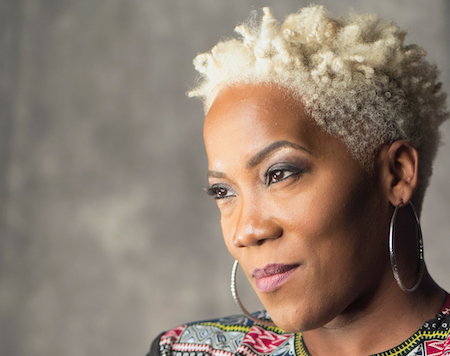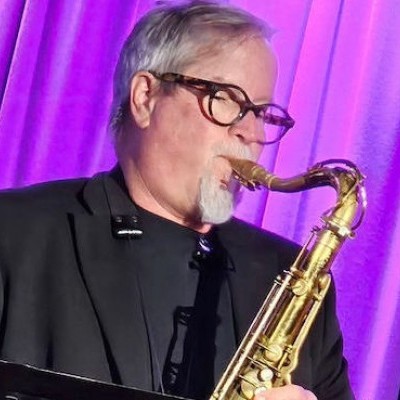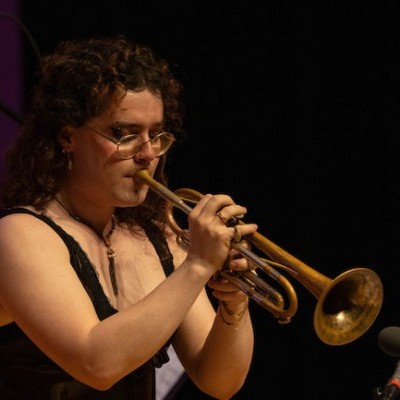Oct 28, 2025 10:47 AM
In Memoriam: Jack DeJohnette, 1942–2025
Jack DeJohnette, a bold and resourceful drummer and NEA Jazz Master who forged a unique vocabulary on the kit over his…

“This music is about contemplation and meditation,” JoVia Armstrong said of The Antidote Suite.
(Photo: Michael Jackson)JoVia Armstrong specializes in creating sonic universes. That ingenuity goes beyond her gifts as a drummer, percussionist and composer as evidenced by her debut album, The Antidote Suite (Black Earth Music), an engrossing, Afrofuturist voyage centered on healing.
Threads of techno, future soul, hip-hop and chamber jazz float throughout the five-part adventure as Armstrong sublimely reconciles electronic ingenuity and left-wing jazz improvisation. She crafts the music with her Eunoia Society, a group of kindred spirits who collectively perform euphoric improvisations intended to seduce audiences into personal introspection. With Armstrong playing a hybrid cajon drum kit, the remaining members consist of electric bassist Damon Warmack and violinist/viola player Leslie DeShazor. The music broadens with guests that include guitarist Jeff Parker, bassist Isaiah Sharkley, keyboardist Amr Fahmy, singer Yaw Agyeman, rapper Teh’Ray Hale and flutist Nicole Mitchell, who owns Black Earth Music.
“This music is about contemplation and meditation,” Armstrong explained. “Back in the ’60s, we had John Coltrane and Alice Coltrane doing what has been deemed as ‘spiritual jazz.’ I’m going into that realm but using electronics and cave technology. In ancient society, people would go into caves to worship, to do rituals, to hold their ceremonies. This is a place that has a ton of reverb and reflections. There are these reflections, which is what we do when we meditate.”
With her technology experience, Armstrong transports audiences into immersive worlds where the sonic designs travel naturally instead of emitting from conventional front speakers with left and right channels.
In late May, she was preparing for the oral defense of her doctorate dissertation, “Black Space: Composing Meditative Music Through the Black Lens to Combat Unconscious Bias,” at the University of California Irvine. There, she was a doctoral degree candidate in the Integrated Composition Improvisation and Technology program. When explaining the program in which many musicians use electronics to create their art, Armstrong said that she’s more interested manipulating computer hardware than mastering software programs. With her strong background in expansive jazz and R&B, it’s vital for Armstrong to have kinetic live instrumentation in her music. But the manipulations of computer hardware enable the Eunoia Society to provide new personalized colors and textures.
“While we’re playing our instruments, we will hook them up to different hardware devices to create new instruments,” she said before explaining how DeShazor might run her violin through a processor so the audience hears an entirely different instrument. “In my practice, I’m looking at those processed sounds as separate entities. And we can mix the music in a certain way where the audience hears the dry signal of the violin as well.”
When describing her ideal performance setting, Armstrong references Herbie Hancock’s concerts from Future 2 Future (Transparent), his 2001 drum-n-bass heavy album where he used surround sound audio technology. For her concerts, Armstrong prefers a 16-speaker multichannel system and Unity gaming software to create three-dimensional worlds.
“We have various sounds flying around the room,” she said. “We invite the audience to not just sit in their seats and listen but become participants in the sonic world. They were able to walk around the venue and listen to the sounds move around them. In the real world, this is how we hear sound.”
Armstrong grew up in Detroit, where techno, Blackness and pioneering music coincide. The Mother City is home to a swath pioneering Black techno, deep house and hip-hop artists such as Carl Craig, Derrick May, Moodymann, Jeff Mills, Theo Parrish and J Dilla. Detroit was also the city where Parliament-Funkadelic recorded most of its Afrofuturistic funk classics. One of Armstrong’s early mentors was drummer, percussionist Francisco Mora Catlett, who worked with Sun Ra, and has released his own Afrofuturistic works such as the Henry Dumas-inspired Rare Metal.
She continued developing her craft in Chicago, where she linked up with the Association for the Advancement of Creative Musicians. Through drummer Vincent Davis, Armstrong met Mitchell at an ACCM event in 2000. During that time though, Armstrong quit music because of her encounter with rampant sexism. Mitchell began hiring Armstrong regularly, which helped revitalize her music career. “We’ve been working together ever since,” Armstrong said. “She’s a really close friend and a mentor.”
In Chicago, Armstrong taught kids music software like ProTools, Garage Band and Logic. “Now, I want to show Black kids how to build their own computers, because every time I’m at a NAMM show, I don’t see us,” she said. “After years of going to NAMM shows, it really started to dawn upon me, as Black people, we always seem to be accepted as performers. But when it comes to manufacturing, how do we get into those spaces? We know how to use the tools. We’ll learn them inside and out. But what could we do if we built these machines? What type of creativity would we conjure up as technologists? DB

Jack DeJohnette boasted a musical resume that was as long as it was fearsome.
Oct 28, 2025 10:47 AM
Jack DeJohnette, a bold and resourceful drummer and NEA Jazz Master who forged a unique vocabulary on the kit over his…

“I’ve told students, ‘I don’t mind if you use AI for this or that project,’” says MIT’s Pascal Le Boeuf. “‘But you need to tell me.’”
Sep 18, 2025 11:14 AM
A standard joke when it comes to discussing artificial intelligence, or AI, is that it’s developing so rapidly that…

Chuck Manning Works for NASA … and plays jazz.
Sep 18, 2025 11:23 AM
Congratulations! After years of study, you’ve earned your degree in jazz performance. But let’s face it: Making a…

Always a sharp dresser, Farnsworth wears a pocket square given to him by trumpeter Art Farmer. “You need to look good if you want to hang around me,” Farmer told him.
Sep 23, 2025 11:12 AM
When he was 12 years old, the hard-swinging veteran drummer Joe Farnsworth had a fateful encounter with his idol Max…

“Make time and energy to meet people and make friends,” suggests Millie Ahearn, a student at DePaul University.
Sep 18, 2025 11:32 AM
For many students, the transition into a collegiate jazz program can feel overwhelming — new peers, unfamiliar…